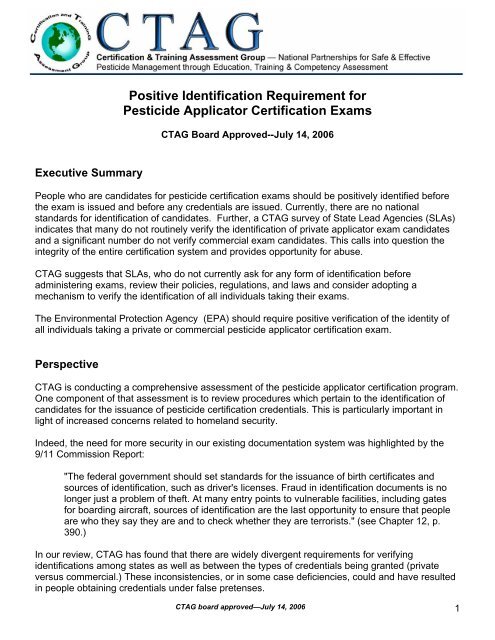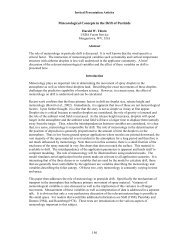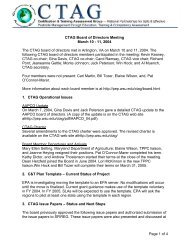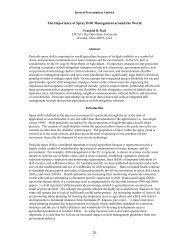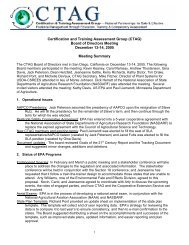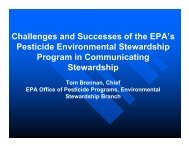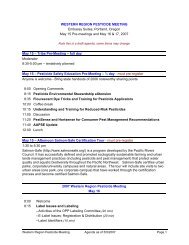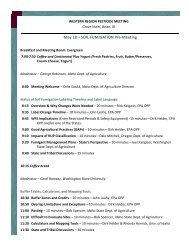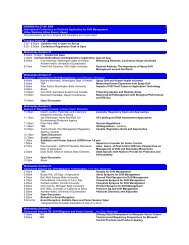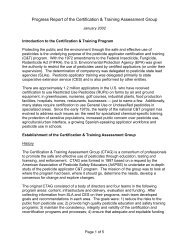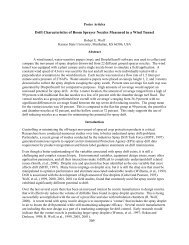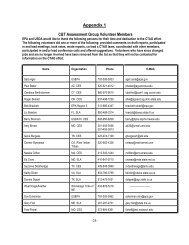Positive Identification Requirement for Pesticide Applicator ...
Positive Identification Requirement for Pesticide Applicator ...
Positive Identification Requirement for Pesticide Applicator ...
You also want an ePaper? Increase the reach of your titles
YUMPU automatically turns print PDFs into web optimized ePapers that Google loves.
<strong>Positive</strong> <strong>Identification</strong> <strong>Requirement</strong> <strong>for</strong><strong>Pesticide</strong> <strong>Applicator</strong> Certification ExamsCTAG Board Approved--July 14, 2006Executive SummaryPeople who are candidates <strong>for</strong> pesticide certification exams should be positively identified be<strong>for</strong>ethe exam is issued and be<strong>for</strong>e any credentials are issued. Currently, there are no nationalstandards <strong>for</strong> identification of candidates. Further, a CTAG survey of State Lead Agencies (SLAs)indicates that many do not routinely verify the identification of private applicator exam candidatesand a significant number do not verify commercial exam candidates. This calls into question theintegrity of the entire certification system and provides opportunity <strong>for</strong> abuse.CTAG suggests that SLAs, who do not currently ask <strong>for</strong> any <strong>for</strong>m of identification be<strong>for</strong>eadministering exams, review their policies, regulations, and laws and consider adopting amechanism to verify the identification of all individuals taking their exams.The Environmental Protection Agency (EPA) should require positive verification of the identity ofall individuals taking a private or commercial pesticide applicator certification exam.PerspectiveCTAG is conducting a comprehensive assessment of the pesticide applicator certification program.One component of that assessment is to review procedures which pertain to the identification ofcandidates <strong>for</strong> the issuance of pesticide certification credentials. This is particularly important inlight of increased concerns related to homeland security.Indeed, the need <strong>for</strong> more security in our existing documentation system was highlighted by the9/11 Commission Report:"The federal government should set standards <strong>for</strong> the issuance of birth certificates andsources of identification, such as driver's licenses. Fraud in identification documents is nolonger just a problem of theft. At many entry points to vulnerable facilities, including gates<strong>for</strong> boarding aircraft, sources of identification are the last opportunity to ensure that peopleare who they say they are and to check whether they are terrorists." (see Chapter 12, p.390.)In our review, CTAG has found that there are widely divergent requirements <strong>for</strong> verifyingidentifications among states as well as between the types of credentials being granted (privateversus commercial.) These inconsistencies, or in some case deficiencies, could and have resultedin people obtaining credentials under false pretenses.CTAG board approved—July 14, 2006 1
BackgroundCurrently, there are no national standards <strong>for</strong> positive identification (i.e., photographicidentification) <strong>for</strong> candidates taking a certification exam. Until May of 2005, there was not even anational standard on the issuance of drivers licenses. (Now there is with the enactment of thefederal “Real ID Act” or Public Law 109-13, see Appendix 1.)States, tribes, and territories vary considerably on requiring some <strong>for</strong>m of positive identification <strong>for</strong>pesticide applicator exam candidates. A CTAG survey conducted in 2002 asked SLAs if positiveidentification was required be<strong>for</strong>e their exam was administered. The results are as follows:• Private applicators, 50 responses:o 17 = yeso 33 = no• Commercial applicators, 50 responses:o 29 = yeso 21 = no• Structural pest control, 3 responses:o 3 = yeso 0 = noWhere positive identification is required, it is usually driven by policy rather than by statutory orregulatory authority. Further, if a policy exists, they are highly variable as demonstrated below:• Washington State Department of Agriculture: Instructions <strong>for</strong> Exam Candidates--Youmust be prepared to present picture identification and to pay all license fees at the time oftesting.• Virginia Department of Agriculture: Instructions <strong>for</strong> Exam Candidates--Commercial<strong>Pesticide</strong> <strong>Applicator</strong> and Registered Technician exams may be taken at any VirginiaDepartment of Motor Vehicles Customer Service Center during business hours. Exams atDMV are given on a touch screen automated system. Written exams may be taken byappointment at the twelve VDACS testing centers listed below. You must have a Notice ofAuthorization and photo identification in order to take an exam at any location. Exams <strong>for</strong>Marine Antifouling Paints (TBT) and Sewer Root Control are not available at DMV sites.• North Dakota State University: Policy <strong>for</strong> Extension Proctors--Clients must be positivelyidentified be<strong>for</strong>e taking the exam. This means that a valid photo identity card issued by astate or federal agency must be requested and reviewed. (Exceptions can be made <strong>for</strong> thephoto requirement if religious belief <strong>for</strong>bids photographs, i.e., the Amish.)• Office of the Indian State Chemist: Instructions <strong>for</strong> Exam Candidates--Upon arriving atthe Assessment Center, you will be required to provide one official government-issuedphoto identification ID listed below and sign a roster identifying yourself as the candidate.You must bring current, unexpired photographic identification as listed below:1. driver’s license with photograph2. passport with photographCTAG board approved—July 14, 2006 2
3. military identification with photograph4. green card with photograph5. DMV identification card with photographNOTE: A temporary driver’s license or any other temporary <strong>for</strong>m of identification, even if itincludes a photograph, is not acceptable.• Texas Structural Pest Control: Policy Instructions <strong>for</strong> Applicants--You must bring apicture ID in order to be allowed to test.Other states, by virtue of their certification systems <strong>for</strong> private applicators, do not confirm theidentity of who actually takes a certification exam because they use an on-line certification tutorial,and/or take home exams. This is the case with Minnesota and South Dakota private applicators.(Note, in recent months, both states have made modifications and are considering further changesto their systems to address this matter.)Further, without requiring some <strong>for</strong>m of positive identification and appropriate exam proctoring, asurrogate could take a pesticide applicator certification exam. This has been documented inseveral states; CTAG has first hand experience with such cases in Washington and North Dakota.Consequently, an unqualified person who has falsely become "certified" and "licensed" couldpurchase any amount of Restricted Use <strong>Pesticide</strong>s (RUP), use or supervise the use of theillegally-purchased pesticides, and in certain instances even use the false credentials to gainaccess to secure pesticide storage facilities. The latter raises serious questions <strong>for</strong> homelandsecurity and <strong>for</strong> simply securing pesticide from people who harbor malicious intent.Q & A regarding positive identification of exam candidatesWhat are the risks to maintaining the status quo?1. We fail to carryout our regulatory obligation to ensure that applicators who use RUPs arewho they purport to be and are competent. This implies to the general public thatcertifications credentials can easily be obtained by untrained and anonymous individuals.2. Unqualified people, that have not demonstrated competence, could easily obtaincredentials.3. Terrorists may easily obtain credentials under false pretenses and may then obtain otherdocuments or material to facilitate their attacks against this country.4. Finally, people who are mentally unbalanced, or who wish to engage in acts of vandalism,assault, or homicide have been known to use pesticides as weapons. Without some minimalsystem of verifying identity, they could engage in these acts without difficulty.CTAG board approved—July 14, 2006 3
Is this an over-reaction to 9/11?CTAG believes checking credentials would provide a layer of security which may revealinconsistencies that could then be shared with and acted upon by law en<strong>for</strong>cement agencies.Further, simply asking questions of candidates <strong>for</strong> exams is not burdensome and would go along ways towards:o Providing minimal deterrence <strong>for</strong> people who would casually abuse the system byobtaining credentials <strong>for</strong> friends, family, or co-workers.o Providing minimal deterrence <strong>for</strong> people who wish to engage in acts of vandalism,malicious destruction, assault, or even homicides with pesticides.o Setting a good example by showing pesticide dealers that checking credentials is notjust the job of those being regulated (the pesticide sales industry) but it is also the jobof regulators (those issuing the credentials).o Complying with federal law and satisfying Congress. Indeed, the Real ID Act impliesthat people need to identify themselves when engaging in activities which could bedistorted and thereby threaten the security of the country. Clearly, making it easy <strong>for</strong>someone to purchase highly toxic pesticides (<strong>for</strong> terrorist purposes) is not consistentwith the desire of decision makers.What about law abiding clients, will they take this as being a high handed and paranoidreaction by bureaucrats?Some candidates may react negatively to this. However, most will not even notice the changesince they already have to produce identification to cash checks or to purchase controlledsubstances (tobacco, prescription and some over the counter drugs, alcohol, or firearms.)Many will see it as a reasonable request which is consistent with the norms and concerns ofsociety.What about people who would object to producing identification <strong>for</strong> religious purposes?A positive identification requirement may present some difficult issues in situations wherelegitimate religious beliefs and practices of some people prohibit them from having theirphotographs taken. For such groups, the airline industry generally requires two <strong>for</strong>ms ofnon-photo identification documents, one of which must be a government-issued identificationdocument such as a social security card which bears the person’s signature. The other <strong>for</strong>m ofidentification may include documents such as a checking statement or a utility bill that showsthe person's name and current address.SLAs may encounter such individuals (the Amish, <strong>for</strong> example) in connection with pesticideapplicator certification or recertification exams. Reviewing multiple <strong>for</strong>ms of non-photoidentification may increase staff time in verifying a person's identity, but this would only occur invery few cases, the vast majority of candidates will have government issued photographicidentification. Regardless, SLAs should refuse to administer a certification or recertificationexam to any individual who cannot be positively identified.CTAG board approved—July 14, 2006 4
What will this cost?The potential impact of requiring positive identification through the use of existing photoidentification documents including a state-issued driver's license (or “non-driver” photoidentification document) or a U.S. government issued passport, military identification card, orimmigration "green" card will be minimal. It should cause little inconvenience <strong>for</strong> the proctor toverify a candidate's identity. In order to minimize staff time, some states collect identification atthe beginning of the exam, review them and then return them to the applicant after the exammaterials are returned.What about states who cannot physically inspect identifications because of the nature oftheir certification systems?These states would have to revamp their systems and this would have at least short termnegative financial impacts. However, implementation of any national standard would take time(at least two to three years), and presumably, in the interim, new resources or alternativeschemes of administering exams could be identified and adopted.RecommendationSLAs who do not currently ask <strong>for</strong> any <strong>for</strong>m of identification be<strong>for</strong>e administering exams shouldreview their policies, regulations, and laws and consider adopting a means of verifying who istaking their exams. All states that lack the necessary legal authority to positively identifycandidates, should begin the process of obtaining it through rule making or via statutes.At the federal level, EPA should implement requirements to positively verify the identity of allindividuals taking a private or commercial pesticide applicator certification exam. To improvesecurity, positive identification should be determined through the use of photo identificationdocuments issued by a U.S. government agency or affiliated jurisdiction (states, tribes, orterritories). Acceptable photo identification documents should be limited to:• a driver's license or “non-driver” photo identification document issued by a state, tribe orterritory,• a U.S. government issued passport,• a U.S. military identification card,• or a U.S. immigration "green" card.Any implementation of a national standard by EPA should include exemption provisions <strong>for</strong> thoseindividuals who are legitimately photo-averse. In these rare instances, at least two <strong>for</strong>ms of nonphotoidentification documents should be required. At least one such document must be agovernment issued document, such as a social security card, which bears the holder’s signature.Other non-photo identification documents must identify the holder by name and address. In allcases, the name of the person taking the exam must match the name on each non-photoidentification document. (These exceptions are consistent with standard practice in the airlineindustry.)CTAG board approved—July 14, 2006 5
Appendix 1The Federal “Real ID” Act, now P.L. 109-13May 11, 2005Title II: Improved Security <strong>for</strong> Driver's Licenses and Personal <strong>Identification</strong> Cards(Sec. 202) Prohibits Federal agencies from accepting State issued driver's licenses or identificationcards unless such documents are determined by the Secretary to meet minimum securityrequirements, including the incorporation of specified data, a common machine-readabletechnology, and certain anti-fraud security features.Sets <strong>for</strong>th minimum issuance standards <strong>for</strong> such documents that require: (1) verification ofpresented in<strong>for</strong>mation; (2) evidence that the applicant is lawfully present in the United States; and(3) issuance of temporary driver's licenses or identification cards to persons temporarily presentthat are valid only <strong>for</strong> their period of authorized stay (or <strong>for</strong> one year where the period of stay isindefinite).(Sec. 203) Requires States, as a condition of receiving grant funds or other financial assistanceunder this title, to participate in the interstate compact regarding the sharing of driver's license data(the Driver License Agreement).(Sec. 204) Amends the Federal criminal code to prohibit trafficking in actual as well as falseauthentication features <strong>for</strong> use in false identification documents, document-making implements, ormeans of identification.Requires the Secretary to enter into the appropriate aviation security screening databasein<strong>for</strong>mation regarding persons convicted of using false driver's licenses at airports.(Sec. 205) Authorizes the Secretary to make grants to assist States in con<strong>for</strong>ming to the minimumstandards set <strong>for</strong>th in this title.(Sec. 206) Gives the Secretary all authority to issue regulations, set standards, and issue grantsunder this title. Gives the Secretary of Transportation all authority to certify compliance with suchstandards.Authorizes the Secretary to grant States an extension of time to meet the minimum documentrequirements and issuance standards of this title, with adequate justification.(Sec. 207) Repeals overlapping document provisions of the IRTPA.(Sec. 208) States that nothing in this title shall be construed to affect the authorities andresponsibilities of the Secretary of Transportation or the States under existing laws governing theestablishment of a National Driver Register.CTAG board approved—July 14, 2006 6


